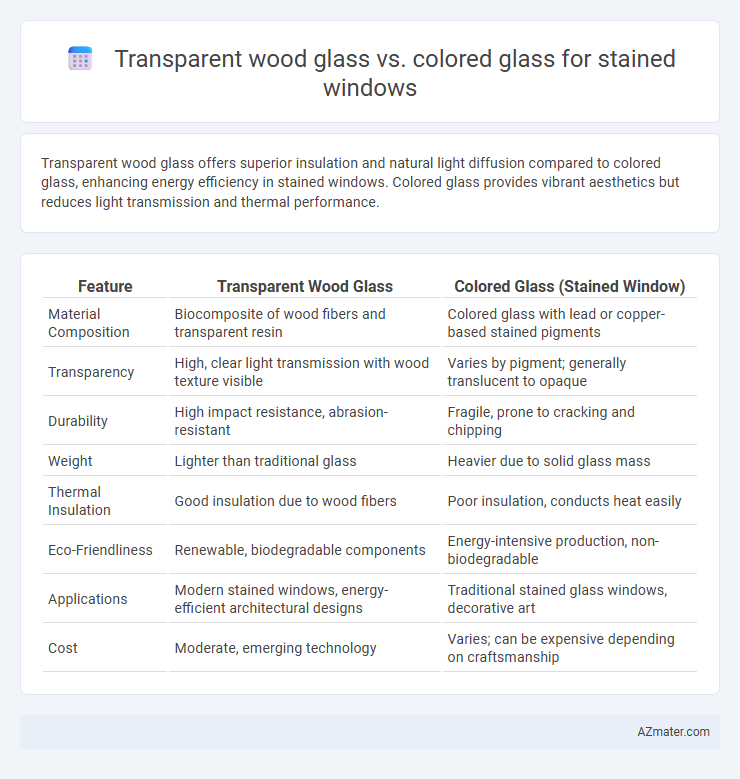Transparent wood glass offers superior insulation and natural light diffusion compared to colored glass, enhancing energy efficiency in stained windows. Colored glass provides vibrant aesthetics but reduces light transmission and thermal performance.
Table of Comparison
| Feature | Transparent Wood Glass | Colored Glass (Stained Window) |
|---|---|---|
| Material Composition | Biocomposite of wood fibers and transparent resin | Colored glass with lead or copper-based stained pigments |
| Transparency | High, clear light transmission with wood texture visible | Varies by pigment; generally translucent to opaque |
| Durability | High impact resistance, abrasion-resistant | Fragile, prone to cracking and chipping |
| Weight | Lighter than traditional glass | Heavier due to solid glass mass |
| Thermal Insulation | Good insulation due to wood fibers | Poor insulation, conducts heat easily |
| Eco-Friendliness | Renewable, biodegradable components | Energy-intensive production, non-biodegradable |
| Applications | Modern stained windows, energy-efficient architectural designs | Traditional stained glass windows, decorative art |
| Cost | Moderate, emerging technology | Varies; can be expensive depending on craftsmanship |
Introduction to Transparent Wood Glass and Colored Stained Glass
Transparent wood glass offers a modern alternative to traditional stained glass by combining natural wood fibers with transparent polymers to create a lightweight, durable, and eco-friendly material that mimics the aesthetic appeal of glass while enhancing insulation properties. Colored stained glass, crafted by adding metallic salts during its molten state, delivers vibrant hues and intricate designs that have been historically valued for decorative and artistic purposes in windows. Both materials serve distinct architectural and design functions, with transparent wood glass emphasizing sustainability and thermal performance, while colored stained glass focuses on rich color expression and light diffusion.
Material Composition and Manufacturing Processes
Transparent wood glass for stained windows consists of cellulose fibers from wood infused with polymers, offering high light transmittance and thermal insulation, while colored glass is composed of silica sand combined with metal oxides or sulfides for pigmentation, requiring precise melting and cooling techniques to achieve desired hues. The manufacturing process of transparent wood glass involves delignification, polymer infiltration, and curing to maintain structural integrity and transparency, contrasted with colored glass production that relies on batch melting, controlled annealing, and sometimes painting or etching for design details. Transparent wood glass benefits energy efficiency and sustainability, whereas colored glass prioritizes vivid coloration and traditional craftsmanship in stained window applications.
Optical Clarity and Light Transmission
Transparent wood glass exhibits higher optical clarity and superior light transmission compared to colored glass in stained window applications, allowing more natural light to pass through while maintaining structural strength. Colored glass reduces light transmission due to its pigmentation, leading to lower brightness and potential visual distortion, which can affect the overall illumination quality inside a space. Opting for transparent wood glass enhances both energy efficiency and aesthetic appeal by providing clearer views and brighter interiors without compromising privacy.
Aesthetic Differences: Natural vs. Vibrant Colors
Transparent wood glass offers a natural, warm aesthetic that enhances light diffusion with subtle wood grain textures, creating an organic ambiance. Colored glass for stained windows delivers vibrant, bold hues that produce striking visual contrasts and dramatic lighting effects. The choice between transparent wood glass and colored glass hinges on whether a subdued, earthy appearance or a vivid, artistic expression is desired.
Energy Efficiency and Insulation Properties
Transparent wood glass offers superior thermal insulation compared to colored glass, reducing heat transfer and maintaining indoor temperatures more effectively. Its unique cellulose structure allows for natural light diffusion while minimizing energy loss, enhancing overall energy efficiency in stained window applications. Colored glass, while aesthetically vibrant, tends to have higher thermal conductivity, leading to greater heat gain or loss and reduced insulation performance.
Durability and Maintenance Requirements
Transparent wood glass offers superior durability compared to colored glass for stained windows, as its composite structure resists cracking, shattering, and UV damage more effectively. Maintenance is minimal due to its inherent resistance to moisture and temperature fluctuations, reducing the need for frequent cleaning or repairs. Colored glass, while visually vibrant, often requires careful handling and periodic restoration to maintain its appearance and structural integrity.
Environmental Impact and Sustainability
Transparent wood glass offers superior sustainability compared to colored glass for stained windows due to its renewable raw material base and lower energy consumption during production. It provides excellent thermal insulation, reducing the need for artificial heating and cooling, thereby minimizing the building's carbon footprint. Colored glass, often produced with heavy metals and chemicals, poses greater environmental hazards in manufacturing and disposal, making transparent wood glass a greener alternative.
Customization Options for Design and Architecture
Transparent wood glass offers superior customization options for stained windows by allowing precise control over translucency and texture, enabling architects to create unique light diffusion effects without compromising structural integrity. Colored glass provides a broad palette of hues and traditional patterns, but customization often requires complex layering or painting techniques that can affect durability and maintenance. Combining transparent wood glass with colored elements enhances design flexibility, offering both innovative aesthetics and sustainable architectural solutions.
Cost Comparison: Installation and Long-Term Value
Transparent wood glass offers a cost-effective installation compared to traditional colored glass for stained windows, as it requires less specialized labor and customization. Over time, transparent wood glass demonstrates superior long-term value due to its enhanced durability, energy efficiency, and lower maintenance costs. Colored glass, while aesthetically traditional, often incurs higher repair and replacement expenses, impacting overall investment.
Future Trends in Window Technology and Architectural Design
Transparent wood glass offers superior thermal insulation and sustainability compared to colored glass, making it a leading material in future window technology development. Innovations in transparent wood composites enable customizable light diffusion while maintaining structural strength, appealing to architects aiming for eco-friendly, energy-efficient designs. Colored glass remains popular for its aesthetic versatility, but emerging trends favor transparent wood glass for integrating natural translucency with advanced performance in smart building facades.

Infographic: Transparent wood glass vs Colored glass for Stained window
 azmater.com
azmater.com